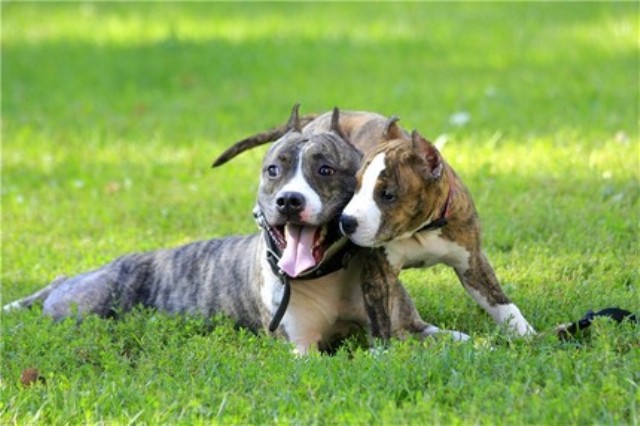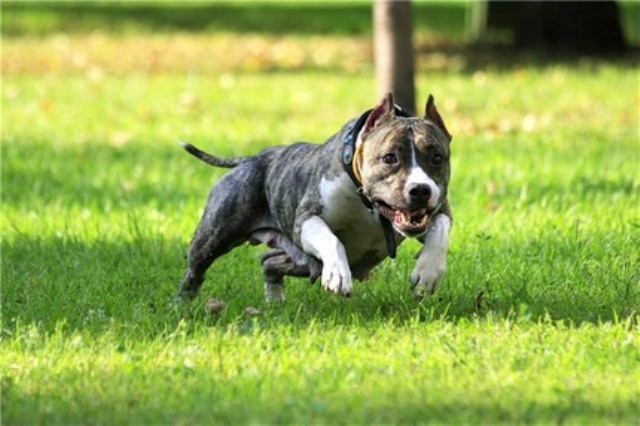|
ABOUT THE BREED
|
|



 |
The American
Staffordshire terrier is a medium-sized, short-coated dog
breed whose early ancestors came from England. In the early
part of the twentieth century the breed gained social stature
and was accepted by the American Kennel Club as the American
Staffordshire Terrier in 1936. The name was changed to reflect
difference from the Staffordshire Bull Terrier of England.
The early ancestors of this breed come from England, where
applications included farm use, guarding, dog fighting, and
companionship. Until the first part of the 19th century, the
Bulldog was bred in England for the purpose of baiting bulls.
Bulldogs pictured as late as 1870 resemble contemporary
American Staffordshire Terriers to a greater degree than
present-day Bulldogs. Some writers contend it was the White
English Terrier, Fox Terrier, or the Black and Tan Terrier
that was crossed with the Bulldog to develop the Staffordshire
Terrier; all three breeds shared many traits, the greatest
differences being in color, aggressiveness, and spirit. The
cross of Bulldog and Terrier was called by several names,
including Bull-and-Terrier Dog, Half and Half, and Pit Dog or
Pit Bull terrier. Later, it assumed the name of Staffordshire
Bull Terrier in England. These dogs began to find their way
into America as early as 1870, where they became known as the
Pit Dog and Pit Bull Terrier, then the American Bull Terrier,
and still later as the Yankee Terrier.
Popularity
American Staffordshire terriers gained in popularity in the
1920s with "Pete the Pup's" appearances in the Our Gang (The
Little Rascals) comedies, contributing to the spread of the
breed.
In 1936, they were accepted for registration in the AKC Stud
Book as Staffordshire Terriers, belonging to the terrier and
molosser groups. The name of the breed was revised January 1,
1972 to American Staffordshire Terrier; breeders in the United
States had developed a variety which was heavier in weight
than the Staffordshire Bull Terrier of England - the name
change was to distinguish them as separate breeds.
The breed's popularity began to decline in the United States
following World War II.
Images of the breed were used to represent the US during the
1900s as a depiction of strength and dignity.
The American Temperament Test Society conducts tests every
year on thousands of dogs to determine the soundness of their
temperament. Data is cumulative since the start of ATTS in
1977 and the pass-fail rate is not a measure of a breed's
aggression, but rather of each dog's ability to interact with
humans, human situations, and the environment. At an 84.2 pass
ratio the American Staffordshire Terrier ranks above many more
popular breeds such as the Beagle at 80.9%, Collie at 79.9%
and the Dalmatian at 82.4%. Intelligence, human attenuation,
energy, and affection are characteristic of the breed. The Am
Staff is a people-oriented dog that thrives when he is made
part of the family and given a job to do. Although friendly,
this breed is loyal to his family and will protect them from
any threat.
American Staffordshire Terrier History
To correctly give the origin and history of the American
Staffordshire Terrier, it is necessary to comment briefly on
two other dogs, namely the Bulldog and the terrier.
Until the early part of the 19th century; the Bulldog was bred
with great care in England for the purpose of baiting bulls.
The Bulldog of that day was vastly different from our
present-day "sourmug." Pictures from as late as 1870 represent
the Bulldog as agile and as standing straight on his legs-his
front legs in particular. In some cases he was even possessed
of a muzzle, and long rat tails were not uncommon. The Bulldog
of that day, with the exception of the head, looked more like
the present-day American Staffordshire Terrier than like the
present-day Bulldog.
|
|
ABOUT BREED
STANDART FCI
|
Some writers contend it was the white
English Terrier, or the Black-and-Tan Terrier, that was used
as a cross with the Bulldog to perfect the Staffordshire
Terrier. It seems easier to believe that any game terrier,
such as the Fox Terrier of the early 1800s, was used in this
cross, since some of the foremost authorities on dogs of that
time state that the Black-and-Tan and the white English
Terrier were none too game, but these same authorities go on
to stress the gameness of the Fox Terrier. It is reasonable to
believe that breeders who were attempting to perfect a dog
that would combine the spirit and agility of the terrier with
the courage and tenacity of the Bulldog, would not use a
terrier that was not game. In analyzing the three
above-mentioned terriers at that time, we find that there was
not a great deal of difference in body conformation, the
greatest differences being in color, aggressiveness, and
spirit.
In any event, it was the cross between the Bulldog and the
terrier that resulted in the Staffordshire Terrier, which was
originally called the Bull-and-Terrier Dog, Half and Half, and
at times Pit Dog or Pit Builterrier. Later, it assumed the
name in England of Staffordshire Bull Terrier.
These dogs began to find their way into America as early as
1870, where they became known as Pit Dog, Pit Bull Terrier,
later American Bull Terrier, and still later as Yankee
Terrier.
In 1936, they were accepted for registration in the AKC Stud
Book as Staffordshire Terriers. The name of the breed was
revised effective January 1, 1972 to American Staffordshire
Terrier. Breeders in this country had developed a type which
is heavier in weight than the Staffordshire Bull Terrier of
England and the name change was to distinguish them as
separate breeds.
The American Staffordshire Terrier's standard allows a
variance in weight, but it should be in proportion to size.
The dog's chief requisites should be strength unusual for his
size, soundness, balance, a strong powerful head, a
well-muscled body, and courage that is proverbial.
To clarify the confusion that may exist, even in the minds of
dog fanciers, as to the difference between the American
Staffordshire Terrier and the Bull Terrier, a comment on the
latter may be helpful. The Bull Terrier was introduced by
James Hinks of Birmingham, who had been experimenting for
several years with the old bull-and-terrier dog, now known as
Staffordshire. It is generally conceded that he used the
Staffordshire, crossed with the white English Terrier, and
some writers contend that a dash of Pointer and Dalmatian
blood was also used to help perfect the all-white Bull
Terrier.
In mentioning the gameness of the Staffordshire, it is not the
intention to tag him as a fighting machine, or to praise this
characteristic. These points are discussed because they are
necessary in giving the correct origin and history of the
breed. The good qualities of the dogs are many, and it would
be difficult for anyone to overstress them.
|
|
|


